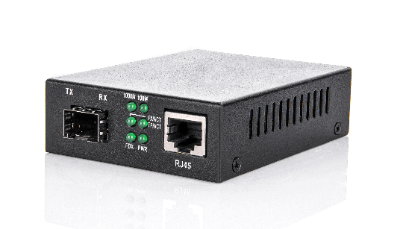What Is a Media Converter?
 A media converter is a device for connecting a metal cable, which transmits information using electrical signals, and an optical fiber, which transmits information using light as the medium.
A media converter is a device for connecting a metal cable, which transmits information using electrical signals, and an optical fiber, which transmits information using light as the medium.
A media converter is a device for mutually converting signals in different media, but the media used here are limited to electrical and optical signals. In other words, a media converter is a device that converts electrical signals into optical signals and optical signals into electrical signals, and is also called an optical media converter or MC.
Uses of Media Converters
Media converters are used to connect metal cables, which transmit information using electrical signals, and optical fibers, which transmit information using light as the medium. Metal cables that transmit electrical signals are susceptible to electromagnetic noise as well as signal attenuation as the transmission distance increases. Therefore, the transmission distance is limited to about 100 m.
On the other hand, transmission of optical signals by optical fiber is not affected by electromagnetic noise and is less susceptible to signal attenuation, making it ideal for transmission over long distances. However, since the signal medium is different between metal cables, which transmit signals based on voltage changes, and optical fiber, which transmits signals based on light flashes, the signals must be converted to each other in order to connect the two.
Therefore, a network line that takes advantage of the strengths of each cable is constructed by intervening media converters and mutually converting the two types of signals.
Principle of Media Converters
Typically, a pair of media converters is installed at both ends of an optical fiber connecting two networks built with metal cables. The first media converter converts the electrical signals of the metal cable to optical signals of the optical fiber. The electrical signal input to the media converter is transmitted to a light emitting device such as a laser diode, and output to the fiber optic cable as an optical signal modulated in response to the signal.
The second media converter converts the sent optical signal into a change in voltage by means of a light-receiving element and restores it to the original electrical signal. This mechanism enables reliable signal transmission over long distances using an optical fiber between the two networks.
Media converters can also be classified into the following two types according to the way packet signals are processed.
1. Repeater Type
This type is characterized by the fact that the transmission speed of the electrical signal side is equal to that of the optical signal side. When the communication speeds are the same, conversion can be performed without delay. In other words, when a media converter receives a packet of electrical signals, it immediately converts it into optical signals and outputs them regardless of their contents.
There is no signal delay time, making this mechanism suitable for applications where transmission speed is critical and signal delays are not tolerated. In addition, any packet can be used regardless of the communication protocol, as it passes through without modification. Even if an error packet exists, it is not discarded. This is effective when monitoring equipment to grasp information on equipment trouble and utilize it for countermeasures.
2. Bridge Type
In the bridge type, the packet signal sent from the transmitting side is once received by the media converter on the transmitting side in a buffer circuit. It then converts them to optical signals and transmits them to the media converter on the receiving side.
Therefore, this type can handle cases where the communication speeds of electrical and optical signals are different, and is also called a switch type. Another feature of this type is that communication can be continued without any problems, even if the communication speed between the connected devices is changed for some reason.
Compared to the repeater type, the transmission delay is larger due to the buffer circuit, and the larger the packet length to be transmitted, the more noticeable the delay becomes. On the other hand, the bridge type can determine and remove error packets as soon as the signal is received in the buffer circuit.
Other Information on Media Converters
1. Support for Single/Double-Core Optical Fiber Cables
Generally, a dual-core type is used for optical fiber communications. This is a communication method that uses a dedicated optical fiber core for each of the transmitting and receiving sides, which is usually connected using a cable with two cores in one set. Since light always travels in a fixed direction, the structure of the media converter is simple.
On the other hand, there is a single-core type that uses a single optical fiber core to pass light in both directions, i.e., bidirectional communication. This type of media converter is often used in environments where space is limited, such as when many optical fibers need to be passed through. In single-core bidirectional communications, opposing media converters use light sources with different wavelengths, so the light receiving element must also be sensitive to the wavelength of the other side.
In other words, single-core media converters must be equipped with light sources of different transmit wavelengths from each other, and the light-receiving part must be a combination of light-receiving elements with light-receiving elements that match the transmit wavelength of the other side.